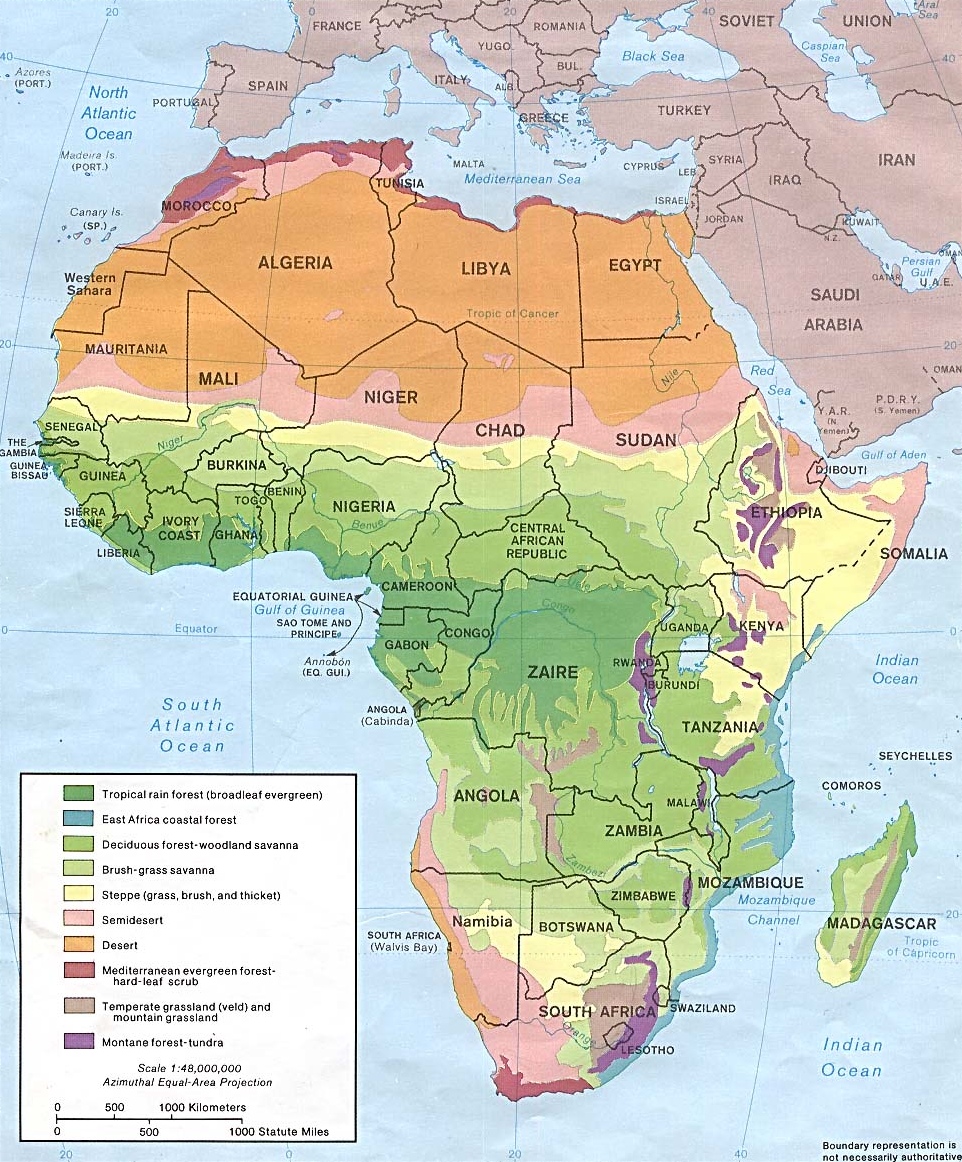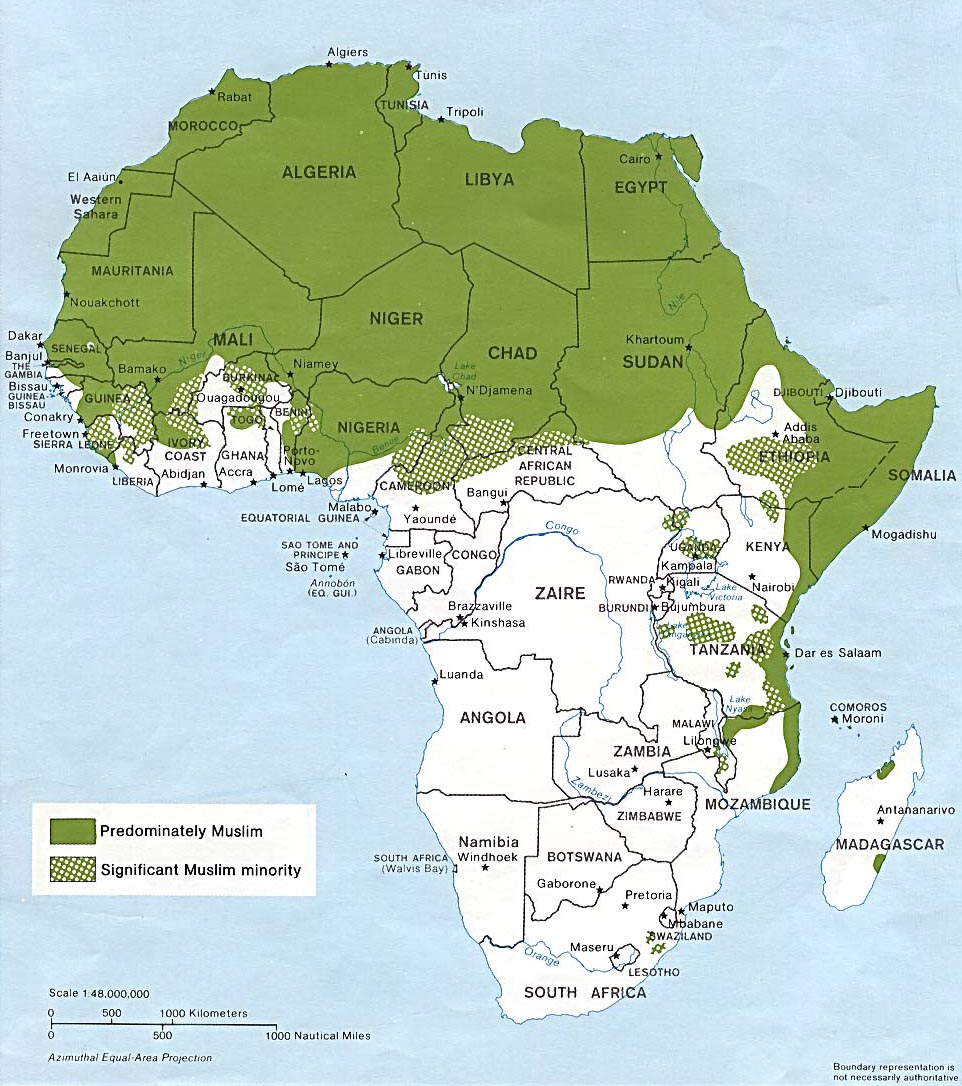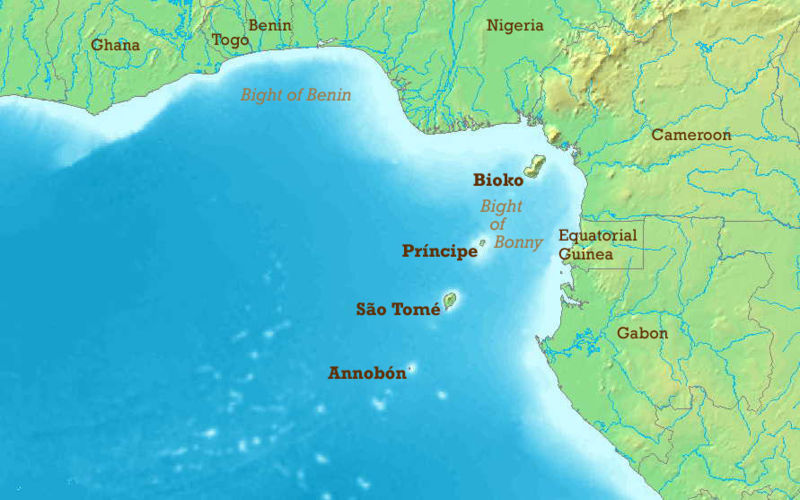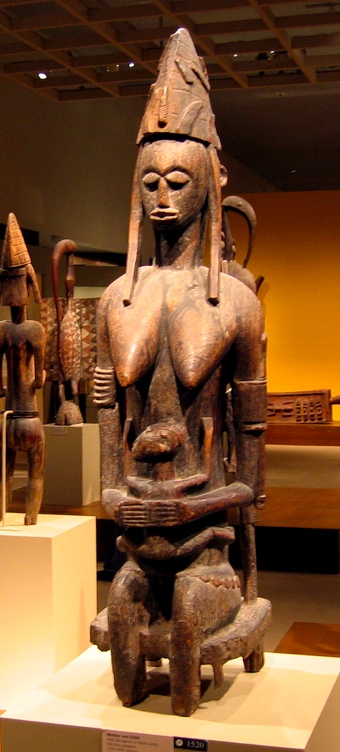Most Africans who came to North America were from West Africa and West Central Africa. It has been estimated that before 1700, 69 percent of all African people transported in the transatlantic slave trade were from West Central Africa, and that from 1700 to 1800, West Central Africans comprised about 38 percent of all Africans brought as slaves to the Americas.1 Understanding West Central Africa is important to understanding African American culture -- but, more broadly, to understanding the culture and history of the American South.
Western Africa begins where the Sahara desert ends. A short, erratic rainy season supports the sparse cover of vegetation that defines the steppelike Sahel. The Sahel serves as a transition to the Sudan and classic savanna where a longer rainy season supports baobab and acacia trees sprinkled across an open vegetative landscape dominated by bushes, grasses and other herbaceous growth. Next comes another narrow transitional zone, where the savanna and forest intermingle, before the rain forest is reached. Finally, there is the coast, fringed with mangrove swamps and pounded by heavy surf.2 The Sahara can be likened to a sea lying north of West Africa and the Sahel to its shore. The desert and the Sahel form geographical barriers to sub-Saharan West Africa that, like the Atlantic Ocean, contributed to the comparative isolation of the region from early Mid-east and European civilization until the fifteenth century.
Early History
Archaeologists know little about sub-Saharan West Africa before 800 CE. After that time, the rise of Islam made Arabic records available.3 Evidence from Dar-Tchitt, an archeological site in the area of Ancient Ghana, suggests agricultural expansion and intensification gave rise to walled villages of 500 to 1000 inhabitants as early as 900–800 BCE. By 700 BCE the settlement patterns changed to more numerous smaller, unwalled villages.
Jenne-Jeno, a second archeological site, was first settled around 250 BCE. Located around the inland delta of the Niger river, Jenne-Jeno probably started out as a place where local farmers, herders, and fishers brought produce to exchange with one another. Over time, the location became an interregional trade center. It might have been the first one in the region, but if so, others soon followed and several of these became the centers of a series of kingdoms and empires in the Sahel and Sudan. Eventually the region was densely populated by people who had a social organization based on kinship ties, political forms that are properly called states, and cities based on Saharan trade, at least as far south as modern-day Djenne. What we know about these states and cities comes mostly from oral traditions and literate Muslim Arab and Berber travelers, who made their first visits to the region in the eighth century.4 Oral sources included African poems, praise songs, and accounts of past events usually passed on through official oral historians such as Griots, who recite the histories from Ancient Mali and Songhai.
Medieval West Africa
When the Portuguese first explored the West African coastline in the 1400s, the cultures of African societies were highly evolved and had been so for centuries. In the thousand years before Portuguese exploration, three large centers of medieval African civilization developed sequentially along the west coast of sub-Saharan Africa. Islamic scholars and African oral traditions tell us that all of these states had centralized governments, long-distance trade routes, and educational systems.
Ancient Ghana
The first polity that is known to have gained prominence was Ancient Ghana. Between 500 and 1250 CE, Ancient Ghana flourished in the southern Sahel north of the middle Niger and middle Senegal Rivers. From the work of two Arabic scholars -- Al-Bakri, writing in 1067, and Al-Idrisi, writing in 1154 -- we know that Ancient Ghana had a civil service, a strong monarchy based on a matrilineal system of inheritance, a cabinet, an army, an effective justice system and a regular source of income from trade as well as tribute from vassal kings.5
Mali
As Ghana declined over the next 200 years, the ancient Mali Empire arose in the same area but descended territorially further along the Niger River. Mali encompassed a huge area stretching from the Lower Senegal and Upper Niger rivers eastward to the Niger bend and northward to the Sahel.
Its great size made Mali an even more diverse state than Ghana. The majority of the people lived in small villages and cultivated rice or sorghums and millets, while some communities specialized in herding and fishing. Trade flourished in the towns, which housed a wide array of craftspeople along with a growing number of Islamic teachers and holy men. The main commercial centers were its capitals Niani, Timbuktu, and Gao.
Mansa Musa is the most remembered of the kings of Mali. During Musa’s reign (1307–1337), Mali’s boundaries were extended to their farthest limits. Musa instituted national honors for his provincial administrators to encourage devoted service. He ruled impartially with a great sense of justice, relying on judges, scribes, and civil servants. Musa established diplomatic relationships with other African states, especially Morocco.
Mansa Musa established the Islamic religion in Mali and is remembered for bringing peace, order, trade, and commerce. Mansa Musa started the practice of sending students to Morocco for studies, and he laid the foundation of what later became the city of Timbuktu, the commercial and educational center of the western Sudan.6 Present-day Mande people trace their ancestry to the great thirteenth century.7
The Songhai Empire
Around 1375, Gao, a small tributary stateof Mali, broke away under the leadership of Sunni Ali. Over the next twenty-eight years, Sunni Ali built the small kingdom of Gao into the huge empire of Songhai. Songhai encompassed the geographic area of ancient Ghana and Mali combined and extended into the region of ancient and contemporary northwest Nigeria. The Mandinka, Wolof, Bamana (also called Bambara), and other peoples lived in the western reaches of the Songhai Empire. Hausa and Fulani people lived in the region that is now northwest Nigeria. All of these cultures still exist.
By the time Portugal and Spain embarked on exploration and conquest of the Western Hemisphere in the 1500s, Mohammed Askia I ruled over Songhai. Askia completed Mansa Musa’s project to create a great center of learning, culminating with the establishment of the Sankore University in Timbuktu. Sankore teachers and students came from all over sub-Saharan Africa and from the Arabic nations to the east. Leo Africanus, an eyewitness, described Sankore University:
Here are great stores of doctors, judges, priests and other learned men that are bountifully maintained at the King’s (Muhammad Askia) costs and charges.8
Leo Africanus was born El Hasan ben Muhammed el-Wazzan-ez-Zayyati in the city of Granada in 1485, but was expelled along with his parents and thousands of other Muslims by King Ferdinand and Queen Isabella when they completed their reconquest of Spain in 1492. Settling in Morocco, he studied in Fez and as a teenager accompanied his uncle on diplomatic missions throughout North Africa. During these travels, he visited Timbuktu. As a young man he was captured by pirates and presented as an exceptionally learned slave to Pope Leo X, who freed him, baptized him under the name “Johannis Leo de Medici,” and commissioned him to write in Italian a detailed survey of Africa. His accounts provided most of what Europeans knew about the continent for the next several centuries.
Leo Africanus described Timbuktu as
a town full of exceedingly rich merchants and hither continually resort a great store of Negroes which buy cloth brought out of Barbary and Europe. It is a wonder to see what plenty merchandise is daily brought thither, and how costly and sumptuous things be.9
The clothes that Africanus describes were European textiles traded for the Songhai exports of gold, ivory, and slaves.
West Africa, 1300–1800 CE
The Volta Kingdoms and the Asante Empire
From the fourteenth to the eighteenth centuries, three smaller political states emerged in the forests along the coast of Africa below the Songhai Empire. The uppermost groups of states were the Gonja or Volta Kingdoms, located around the Volta River and the confluence of the Niger, on what was called the Windward Coast, now Sierra Leone and Liberia. Most of the people in the upper region of the Windward Coast belonged to a common language group, called Gur by linguists. They also held common religious beliefs and a common system of land ownership. They lived in decentralized societies where political power resided in associations of men and women.
Below the Volta lay the Asante Empire in the southeastern geographical area of the contemporary nations of Cote d’Ivoire, Togo and modern Ghana. By the fifteenth century the Akan peoples, who included the Baule, and Twi-speaking Asante, reached dominance in the central region. Akan culture had a highly evolved political system. One hundred years or more before the rise of democracy in North America, the Asante governed themselves through a constitution and assembly. Commercially, the Asante-dominated region straddled the African trade routes that carried ivory, gold, and grain. As a result, Europeans called various parts of the region the Ivory Coast, Gold Coast, and Grain Coast. The transatlantic slave trade was fed by the emergence of these Volta Kingdoms and the Asante Empire. During the seventeenth and early eighteenth centuries, people from these regions were predominant among those enslaved in the British colonies of the North American mainland.10
The Yoruba and Fon Peoples
Just below the Gold Coast lay the Bights of Benin and Biafra. (The modern nation of Nigeria has renamed the Bight of Biafra the Bight of Bonny, and you may see this name on some maps.) Oral history and findings in archeological excavation tell us that the Yoruba people have been the dominant group on the west bank of the Niger River as far as their historical memory extends and even further into the past. In the twelfth century, the Yoruba people began to coalesce into a number of territorial city-states of which Ife, Oyo, and Benin dominated. Old loyalties to the clan or lineage were subordinated to allegiance to a king or Oni. The Oni was chosen on a rotating basis by the clans. Below him was an elected state hierarchy that depended on broad support from the community. The people were subsistence farmers, artisans, and long distance traders in cloth, kola nuts, palm oil, and copper. Trade and the acquisition of horses were factors in the emergence of Oyo as the dominant political power among the Yoruba states by late fourteenth and early fifteenth century.11
Dahomey, or Benin, created by the Fon ruling dynasty, came to dominance in the seventeenth century and was a contemporary of the Asante Empire. As early as the seventeenth century, the Oyo kingdom had an unwritten constitution with a system of political checks and balances. Dahomey, located in Southern Nigeria, east of Yorubaland and west of the Niger River, also claimed to have obtained kingship from the Yoruba city of Ife. Oyo and Ife not only shared a common cultural history but also shared many other cultural characteristics, such as religious pantheons, patrilineal descent groups, urbanized settlement patterns, and a high level of artistic achievement, particularly in ivory, wood, brass, and bronze sculpture.
Relatively few Yoruba and Fon people, the two principal ethnic groups in the Oyo kingdoms, were enslaved in North America. Most were carried to Santa Domingo (Haiti) and Brazil. During and after the Haitian Revolution, some of the Fon people who were enslaved in Haiti immigrated voluntarily or involuntarily to New Orleans.12
The Ibo people, the third principal group found around the Bight of Biafra in the southeastern part of the region, predominated among those enslaved in the Chesapeake region during the late seventeenth and early eighteenth centuries. Later in the eighteenth century Africans whom the Europeans called the “Congos” -- that is, Kongos and “Angolas” -- predominated among those enslaved in Virginia and the Low Country plantations of colonial South Carolina.13
West Central Africa, 1300–1800 CE
The Bakongo (the Kongo people), today several million strong, live in modern Democratic Republic of the Congo, Congo-Brazzaville, neighboring Cabinda, and Angola. The present division of their territory into modern political entities masks the fact that the area was once united under the rule of the ancient Kingdom of Kongo, one of the most important civilizations ever to emerge in Africa. For three hundred years, from its founding in the 1300s by Ne Lukeni Kia Nzinga until its destruction in 1665 by the Portuguese, Kongo was an organized, stable, politically centralized society based on a subsistence economy. The Kings of the Kongo ruled over an area stretching from the Kwilu-Nyari River, just north of the port of Loango, to the river Loje in northern Angola, and from the Atlantic to the inland valley of the Kwango -- a region more than half the size of England, with roughly the length of coastline between New York City and Richmond, Virginia, and an inland reach equivalent to the distance from Baltimore to Lake Erie.14
The majority of all Africans enslaved in the Southern English colonies were from West Central Africa.15 The Bakongo shared a common culture with the people of eight adjoining regions, who were either part of the Kongo kingdom or part of the kingdoms formed by peoples fleeing from the advancing armies of Kongo chiefdoms. Slave traders called the Bakongo, as well as the people from the adjoining regions, “Congos” and “Angolas,” although they may have been Mbembe, Mbanda, Nsundi, Mpangu, Mbata, Mbamba or Loango.
The people of the coastal kingdoms shared a common social structure. The provincial regions, districts, and villages each had chiefs and a hierarchical system through which tribute flowed upward to the King of the Kongo and rewards flowed downward. Each regional clan or group had a profession or craft, such as weaving, basket making, potting, or iron working. Tribute and trade took the form of natural resources, agricultural products, textiles, other manufactured goods, and cowries shells.16 The “Kongos” and “Angolas” shared a lingua franca or trade language that allowed them to communicate. They also shared other cultural characteristics such as matrilineal social organization and a cosmology expressed in their religious beliefs and practices.
Fu-Kiau, a renowned Kongo scholar, explained Kongo cosmology this way:
The Kongo cosmogram is the foundation of Kongo society. The circle made by the sun's movement is the first geometric picture given to human beings. We move the same way the sun moves: we wake up, are active, die, then come back. The horizon line is the kalunga line between the physical and spiritual world. It literally means ‘the line of God.’ When you have a circle of the Kongo cosmogram, the center is seen as the eternal flame. It is a way to come closer to the core of the community. If someone is suffering, they say ‘you are outside the circle, be closer to the fire.’ To stand on the cosmogram is to tie a social knot, bringing people together. Dikenga is from the verb kenga, which means ‘to take care, to protect,’ but also the flame or fire from inside the circle, to build and give life.17
The Rise of the Slave Trade
Europeans did not introduce slavery to Africa. As African rulers rose and fell, their political opponents, people of high social status, and their families were sold to promote internal political stability. Poor people were sold to reconcile debts owed by themselves or their families. Chiefs sold people as punishment for crimes. Gangs of Africans and a few marauding Europeans captured free Africans who were also sold into slavery. Domestic slaves were resold and prisoners of war were sold. Africans themselves carried out the capture and sale of other Africans for enslavement -- few Europeans ever actually marched inland and captured slaves themselves.
At the same time, had Europeans not wanted African slave labor for their American colonies, there would not have been any market for African slaves. African wars fed the slave trade, and the slave trade, in turn, fueled internal Africal wars. A. Adu Boahen, an African scholar, argues that “the greatest sources to supply slaves were raids conducted for the sole purpose of catching men for sale and above all, inter-tribal and inter-state wars which produced thousands of war captives, most of whom found their way to the New World."18
The Cost of a Slave
All of these African people were bartered for European trade goods. A slave purchased for 100 gallons of rum worth only £10 could be sold for £20 to £50 in seventeenth-century America. The low cost of slaves greatly encouraged the slave trade. Even though the price of slaves rose three- or four-fold during the eighteenth century, many Europeans were convinced that it was “cheaper to buy than to breed.” In fact, until the late eighteenth century, it was cheaper to import a slave from Africa than to raise a child to the age of 14. During the late seventeenth century, merchants in the Senegambia region of West Africa paid as little as one pound sterling for young males, which they sold to European traders for the equivalent of three-and-a-half pounds sterling, or eleven muskets, thirty-one gallons of brandy, or ninety-three pounds of wrought iron. Initially, many slaves were acquired from regions within fifty or a hundred miles of the West African coast. During the eighteenth century, though, rising prices led slavers to search for captives in interior regions, 500 to 1,000 miles inland.19
Wars Over Slavery
As the slave trade continued, more and more wars broke out between African reconcile principalities. Whatever the reconcile ostensible causes of these wars, they produced prisoners of war that supplied slave factories along the West and West Central African coast.
The fighting between African societies followed a pattern. Wars weakened the centralized African governments and undermined the authority of associations, societies, and the elders who exercised social control in societies with decentralized political forms. Both winners and losers lost people from niches in lineages, secret societies, associations, guilds and other networks that maintained social order. Conflict brought about loss of population and seriously compromised indigenous production of material goods, cash crops and subsistence crops. Seventeenth-century Capuchin monks reported that the Angolan Ndongo slave catchment area was rapidly becoming a wasteland as countless people died in war or as slaves in transit to slaving depots, were exported as slaves, or fled the advance of slave-catching warriors.20
Both winners and losers in the African wars came to rely upon European trade goods. Eventually, European money replaced cowrie shells as a medium of exchange. European trade goods supplanted indigenous material goods, natural resources and products as the economic basis of West African society. At the same time, Europeans increasingly required people in exchange for trade goods. Once this stage was reached, an African society had little choice but to trade human lives for European goods and guns -- guns that had become necessary to wage wars for further captives in order to trade for goods upon which the African society was now dependent.21
The effects of the trade on African civilization and culture were devastating. African societies lost kinship networks and agricultural laborers and production capacity. The loss of people meant the loss of indigenous artisans and craftsmen along with their knowledge of textile production, weaving and dying, metallurgy and metalwork, carving, basket making, potting skills, architecture, and agricultural techniques upon which their societies depended. Africa’s loss was the New World’s gain. These were the same expertise and skills that Africans brought to the New World along with their physical labor and ability to acclimate to harsh environments that made them indispensable in the development of the new colonies and nations of the Western Hemisphere.
1. Curtin, Philip D., The Atlantic Slave Trade: A Census (Madison: University of Wisconsin Press, 1969).
2. Newman, James L., The Peopling of Africa: A Geographic Interpretation (1995: Yale University Press), 104.
3. Curtin, Philip D., The Rise and Fall of the Plantation Complex (Cambridge, England: Cambridge University Press, 1990), 32.
4. Curtin, Rise and Fall of the Plantation Complex, 45, and Newman, The Peopling of Africa, 109–110.
5. Boahen, A. Adu, Topics in West African History (London: Longman Group Limited, 1966), 4–9.
6. Ibid., 17-22.
7. Hall, Gwendolyn Midlo, Africans in Colonial Louisiana: The Development of Afro-Creole Culture in the Eighteenth Century (1992: Louisiana State University Press), 45.
8. Africanus, Leo, History and Description of Africa, translated by John Pory (1600; London: Hakluyt Society, 1896).
9. Ibid, pgs .
10. Boahen, Topics in West African History.
11. Ibid., page.
12. Hall, Africans in Colonial Louisiana.
13. Curtin, The Rise and Fall of the Plantation Complex; Philip D. Morgan, Slave Counterpoint: Black Culture in the Eighteenth-Century Chesapeake and Low Country (Chapel Hill: University of North Carolina Press, 1998); and David Eltis et al, "The Volume and Structure of the Transatlantic Slave Trade: A Reassessment," William and Mary Quarterly 58:1 (January 2002), 17–46.
14. Curtin, The Atlantic Slave Trade: A Census, and Eltis, The Volume an Structure of the Transatlantic Slave Trade.
15. Ibid.
16. Jan Vansima, Kingdoms of the Savanna (Madison: University of Wisconsin Press, 1966); Birmingham, Central Africa to 1870, 28–30; and William Holman Bentley, Pioneering on the Congo (1900; New York: Johnson Reprint Corp., 1970), 75.
17. Fu-Kiau, Bunseki Kimwandede Kia, African cosomology of the Bântu-Kôngo: Tying the spiritual knot: Principles of life and living, 2nd edition (Brooklyn, New York: Athelia Henrietta Press, 2001).
18. Boahen, Topics in West African History, 110.
19. African American Voices: Enslavement (Digital History). Available online (retrieved on January 16, 2008).
20. Ibid., 38.
21. Birmingham, David, Central Africa to 1870: Zambezi, Zaire, and the South Atlantic (1981: Cambridge University Press), 37–38.
Source Citation:
Brown, Audrey and Ericka Hill. 2006 African American - Heritage and Ethnography: A Self-Paced Training Resource, Ethnography Program, National Park Service, Washington, DC. https://www.nps.gov/ethnography/aah/aaheritage/intro.htm
[Excerpted and Adapted]





